สวัสดีครับทุกคน ผมคือ Michael Zhang นักเดินทางชาวจีนที่มีประสบการณ์ท่องเที่ยวระดับนานาชาติมายาวนาน หลายปีที่ผ่านมา ผมหลงใหลในการค้นหาประวัติศาสตร์และวัฒนธรรมท้องถิ่นในแต่ละเส้นทาง โดยเฉพาะการค้นหาเรื่องราวลึกซึ้งที่ซ่อนอยู่ในรายละเอียดเล็กๆ สำหรับผมแล้ว การเดินทางไม่ใช่เพียงการชมวิวเท่านั้น แต่คือบทสนทนากับประวัติศาสตร์ที่ยังมีชีวิตอยู่ วันนี้ผมจะพาทุกคนไปรู้จักกับวัดโบราณพันปีแห่งนครเซี่ยงไฮ้ —— วัดจิ้งอัน (Jing’an Temple) หนึ่งในวัดพุทธที่เก่าแก่ที่สุดของเซี่ยงไฮ้ วัดแห่งนี้ไม่เพียงเป็นสถาปัตยกรรมอันวิจิตร แต่ยังเป็นเสมือนโอเอซิสทางจิตใจท่ามกลางมหานครนานาชาติที่ไม่เคยหลับใหลแห่งนี้
สารบัญบทความ
แนะนำวัดจิ้งอัน
วัดจิ้งอัน หรือที่เรียกอีกชื่อว่า “จิ้งอันกู่ซื่อ” ตั้งอยู่ใจกลางนครเซี่ยงไฮ้ ถือเป็นวัดพุทธที่ใหญ่ที่สุดและเก่าแก่ที่สุดแห่งหนึ่งในเมือง วัดแห่งนี้สร้างขึ้นตั้งแต่สมัยราชวงศ์ซ่งตอนต้น มีอายุกว่า 1,000 ปี ไม่ว่าจะเป็นชาวพุทธหรือผู้มาเยือน ต่างก็สามารถสัมผัสความสงบทางจิตใจได้ที่นี่ วัดจิ้งอันจึงเป็นสถานที่ที่เหมาะสำหรับการพักผ่อนจิตใจและแสวงหาความสงบภายใน
- ที่อยู่: 1686 ถนนหนานจิงตะวันตก, เขตจิงอัน, นครเซี่ยงไฮ้ (Apple Maps/Amap)
- เวลาทำการ: 7:30 น. – 17:00 น.
- ระยะเวลาที่แนะนำในการเยี่ยมชม: 1-2 ชั่วโมง
- ฤดูกาลที่ดีที่สุดในการเยี่ยมชม: ตลอดทั้งปี
- ราคาตั๋ว: 50 หยวน
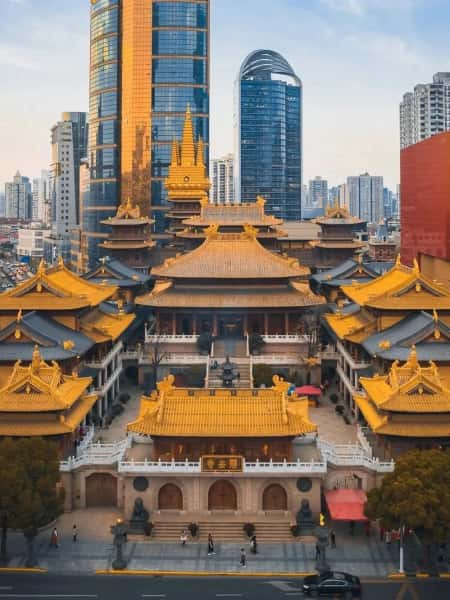
ทำไมต้องไปวัดจิ้งอันสักครั้ง?
เหตุผลที่ทำให้วัดจิ้งอันกลายเป็นหนึ่งในสถานที่ที่ต้องไปเยือน ไม่ได้อยู่ที่มูลค่าการก่อสร้างกว่า 2.8 หมื่นล้านหยวนเท่านั้น แต่ยังอยู่ที่รากฐานทางวัฒนธรรมอันลึกซึ้ง วัดแห่งนี้เริ่มสร้างตั้งแต่สมัยสามก๊ก และยังคงเป็นที่พึ่งทางใจของผู้คนท่ามกลางมหานครที่เต็มไปด้วยความเร่งรีบ บรรยากาศภายในวัดช่วยให้ผู้มาเยือนหลีกหนีจากความวุ่นวายในชีวิตประจำวัน และได้พบกับความสงบภายในจิตใจ การยืนอยู่ท่ามกลางวัดโบราณพันปีแห่งนี้ ทำให้คุณเหมือนได้สนทนากับประวัติศาสตร์ที่ยาวนาน และสัมผัสความสงบที่หาได้ยาก
ประวัติของวัดจิ้งอัน
ประวัติของวัดจิ้งอันสามารถสืบย้อนกลับไปได้ถึงสมัยสามก๊ก โดยเริ่มก่อสร้างในปี ค.ศ. 247 สมัยซุนอู่ ภายใต้ชื่อเดิมว่า “หู่ตู๋จงหยวนซื่อ” ต่อมาในสมัยราชวงศ์ซ่ง ปี ค.ศ. 1008 ได้เปลี่ยนชื่อเป็น “จิ้งอันซื่อ” และในปี ค.ศ. 1216 ช่วงราชวงศ์ซ่งใต้ วัดถูกย้ายจากริมแม่น้ำอู๋ซงมายังที่ตั้งปัจจุบันบนถนนหนานจิงซี ซึ่งเกิดขึ้นก่อนที่นครเซี่ยงไฮ้จะถูกสร้างขึ้นเสียอีก ภายหลังในปี ค.ศ. 1880 สมัยราชวงศ์ชิง วัดได้ถูกบูรณะครั้งใหญ่เนื่องจากพระอุโบสถถล่ม และเริ่มมีงานประเพณีเทศกาลในวันที่ 8 เดือน 4 ตามปฏิทินจันทรคติ ต่อมาในสมัยสาธารณรัฐจีน วัดจิ้งอันกลายเป็นที่ตั้งของสมาคมพุทธศาสนาแห่งจีน และหลังสงครามโลกครั้งที่ 2 ก็ได้รับการบูรณะและขยายหลายครั้ง ทำให้วัดแห่งนี้คงอยู่สืบมาจนถึงปัจจุบัน และยังคงเป็นมรดกทางวัฒนธรรมที่สำคัญของนครเซี่ยงไฮ้
กิจกรรมที่ต้องทำเมื่อมาเยือนวัดจิ้งอัน
สถานที่น่าสนใจภายในวัดจิ้งอัน
ภายในวัดจิ้งอันเต็มไปด้วยสถาปัตยกรรมสำคัญหลายแห่งที่ควรค่าแก่การเยี่ยมชม ทุกแห่งล้วนสะท้อนให้เห็นถึงรากฐานทางพุทธศาสนาอันลึกซึ้งและศิลปะการก่อสร้างที่ประณีตยิ่ง ด้านล่างนี้คือสถานที่สำคัญที่ไม่ควรพลาดเมื่อมาเยือนวัดจิ้งอัน:
หอธรรม (Fǎtáng)
หอธรรมของวัดจิ้งอันตั้งอยู่ทางทิศเหนือของพระอุโบสถ เชื่อมต่อกับพระอุโบสถ ตัวอาคารสูงถึง 32.22 เมตร มีทั้งหมด 7 ชั้น สร้างด้วยไม้สักนำเข้าจากพม่า และมุงหลังคาด้วยกระเบื้องทองแดง หอธรรมแห่งนี้สร้างขึ้นตามหลัก “สถาปัตยกรรมสมัยซ่ง” พร้อมตกแต่งด้วยสัญลักษณ์ทางพุทธศาสนา เช่น ช้าง ธรรมจักร ดอกบัว รวมถึงลวดลายประดับหลังคาอย่างสัตว์ในตำนานและเครื่องยอด การออกแบบโดยรวมเป็นสถาปัตยกรรมจีนโบราณที่ผสมผสานทั้งประตู ศาลา และระเบียง หลังคามุงด้วยกระเบื้องเคลือบสีเหลืองและเทาเข้ม เพิ่มความงดงามด้วยการปิดทอง ทำให้บรรยากาศดูศักดิ์สิทธิ์และน่าเกรงขาม
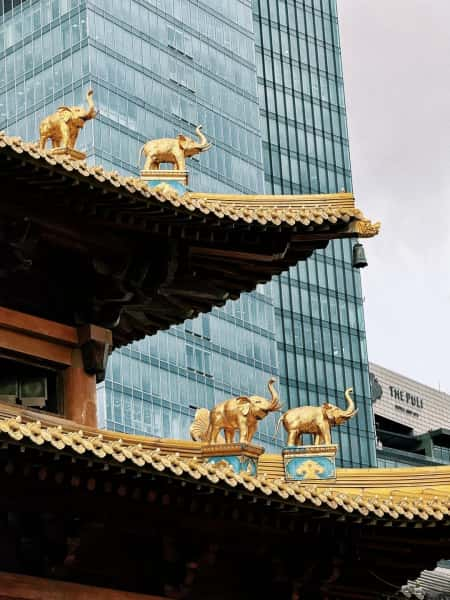
ซานเหมิน (Shānmén)
ซานเหมินของวัดจิ้งอันสร้างรวมกับหอพระสี่ทิศ มีโครงสร้างสองชั้น ผนังภายนอกทำด้วยหินแกรนิต โครงสร้างไม้ใช้ไม้สัก หลังคามุงกระเบื้องเคลือบสีเหลือง บนสันหลังคาสลักอักษร “正法久住” (เจิ้งฝ่าจิ่วจู้) มีความหมายว่า “ความจริงแห่งพระธรรมดำรงอยู่ชั่วกาลนาน” ชั้นล่างมีประตูไม้สักสามบาน ตกแต่งด้วยตะปูทองแดง รอบๆ ประตูแกะสลักเป็นลายมือพระพุทธเจ้า ดอกบัว และสัญลักษณ์มงคลทั้งแปด ด้านหน้ามีคู่กลอนหินสลักที่สื่อถึงความเมตตาและจิตใจที่สงบ ทั้งสองด้านของประตูมีล้อธรรมสลักไว้เป็นสัญลักษณ์พุทธศาสนา ส่วนชั้นสองเป็นระเบียงล้อมด้วยราวหินอ่อนสีขาว ทำให้บรรยากาศยิ่งดูขรึมขลัง
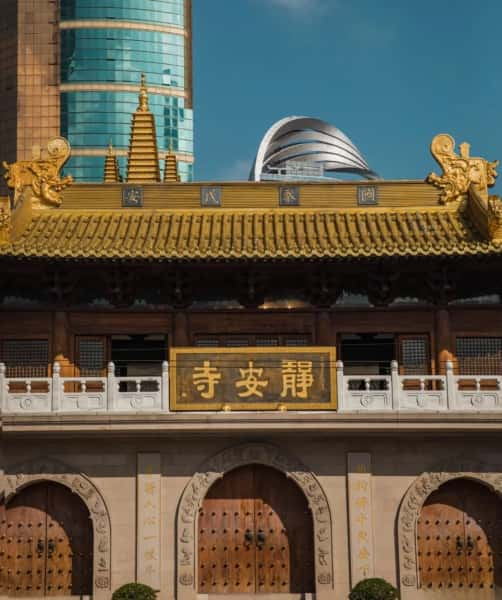
หอระฆัง (Zhōnglóu)
หอระฆังของวัดจิ้งอันแขวน “ระฆังแห่งสันติภาพ” ที่ชั้นสอง ระฆังสูง 3.3 เมตร เส้นผ่านศูนย์กลาง 2.1 เมตร หนักกว่า 7.3 ตัน หล่อด้วยทองสัมฤทธิ์ เสียงระฆังทุ้มกังวานยาวไกล ชั้นล่างของหอระฆังยังได้จำลอง “บ่อน้ำพุ” ซึ่งเป็นหนึ่งใน “แปด景แห่งจิ้งอัน” ที่โด่งดัง น้ำพุแห่งนี้ลึก 6 เมตร ปากบ่อหกเหลี่ยมทำจากหินก้อนใหญ่เพียงก้อนเดียว ก่อสร้างด้วยหินแกรนิตถึง 666 ก้อน โดยก้อนหินก้นบ่อน้ำมีน้ำหนักกว่า 3,000 กิโลกรัม ถือเป็นโครงสร้างที่ประณีตและเป็นหนึ่งในไฮไลท์ที่นักท่องเที่ยวต้องแวะชม
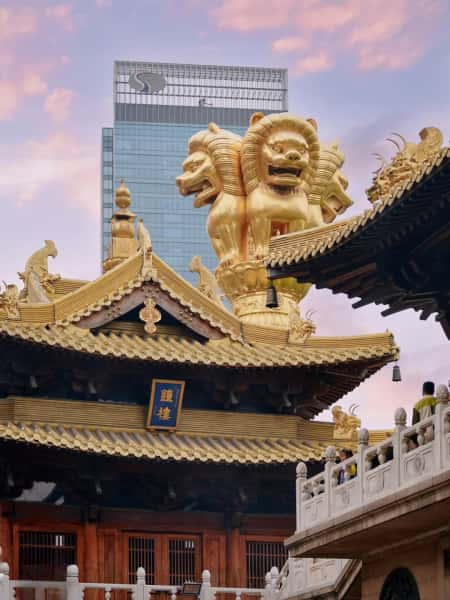
หอเจ้าแม่กวนอิม (Guānyīn Diàn)
หอเจ้าแม่กวนอิมตั้งอยู่ตรงกลางของอาคารด้านตะวันออก สูง 20.6 เมตร ภายในประดิษฐานพระโพธิสัตว์กวนอิมแกะสลักจากไม้หอมทั้งต้น หลังคามุงกระเบื้องเคลือบสีเหลืองตัดกับกระเบื้องสีเทาของอาคารด้านข้าง ทำให้บรรยากาศภายในดูศักดิ์สิทธิ์ยิ่งขึ้น อาคารด้านตะวันออกออกแบบเป็นระเบียงสองชั้น เชื่อมต่อกับซานเหมิน หอระฆัง หอกลอง พระอุโบสถ และหอธรรม ทำให้โครงสร้างโดยรวมเชื่อมโยงกันอย่างกลมกลืน
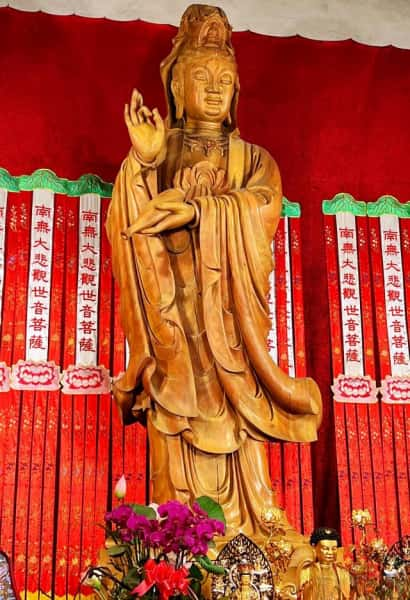
หอมุนี (Móuní Diàn)
หอมุนีตั้งอยู่ทางฝั่งตะวันตก สูง 20.6 เมตร เช่นเดียวกับหอเจ้าแม่กวนอิม ภายในประดิษฐานพระพุทธรูปมุนีแกะสลักจากหยกขาว มีบรรยากาศเคร่งขรึม หลังคามุงด้วยกระเบื้องเคลือบสีเหลืองตัดกับสีเทาของอาคารด้านตะวันตก ทำให้ดูโดดเด่นยิ่งขึ้น โครงสร้างของอาคารด้านตะวันตกเหมือนกับฝั่งตะวันออก เป็นระเบียงสองชั้น และผสานรวมกับซานเหมิน หอระฆัง พระอุโบสถ และหอธรรมอย่างเป็นเอกภาพ
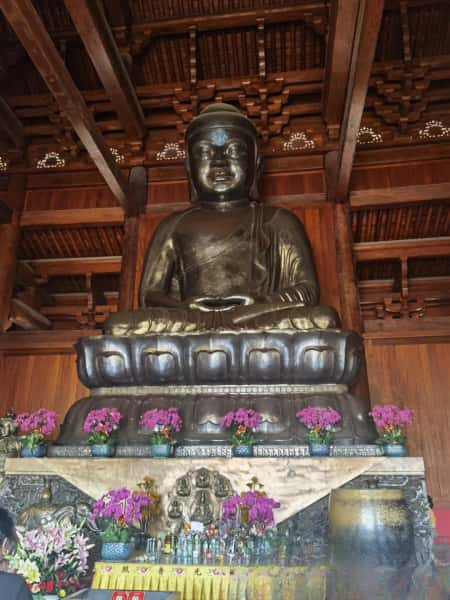
พระอุโบสถใหญ่ (Dàxióng Bǎodiàn)
พระอุโบสถใหญ่ถือเป็นหนึ่งในสิ่งก่อสร้างที่ยิ่งใหญ่ที่สุดของวัดจิ้งอัน ตัวอาคารสูง 26 เมตร ใช้รูปแบบหลังคาซ้อนชั้น ภายในมีเสาไม้สัก 46 ต้น เส้นผ่านศูนย์กลางระหว่าง 0.72–0.8 เมตร ใช้ไม้รวมกว่า 3,000 ลูกบาศก์เมตร หลังคามุงด้วยทองแดง ภายในประดิษฐานพระพุทธรูปศากยมุนีทำจากเงินแท้หนักถึง 15 ตัน ชั้นล่างเป็นห้องบรรยายพระธรรมที่รองรับผู้คนได้กว่าพันคน ส่วนใต้ดินเป็นคลังพระไตรปิฎกขนาด 1,000 ตารางเมตร เก็บรักษาพระคัมภีร์หินแกะสลักกว่า 130,000 แผ่น เพื่อสืบทอดพระพุทธศาสนา
ด้านตะวันออกและตะวันตกของพระอุโบสถใหญ่เป็นอาคารข้างเชื่อมต่อกัน ระเบียงตกแต่งด้วยเสาและราวหินอ่อนแกะสลักดอกบัวอย่างงดงาม ฝั่งตะวันออกมีหอเจ้าแม่กวนอิม ประดิษฐานเจ้าแม่กวนอิมแกะสลักจากไม้หอมเก่าแก่สูง 6.2 เมตร ส่วนฝั่งตะวันตกเป็นหอมุนี ประดิษฐานพระพุทธรูปศากยมุนีทำจากหยกขาว สูง 3.87 เมตร หนักกว่า 11 ตัน บริเวณลานหน้าพระอุโบสถใหญ่มี “ถังธูปมหาสุขและปัญญา” ที่สร้างขึ้นใหม่ น้ำหนัก 15.5 ตัน สูง 10.23 เมตร ทำจากทองสัมฤทธิ์สีขาว ตั้งอยู่บนฐานหินหนัก 36 ตัน และสลักอักษรบันทึกประวัติการสืบทอดวัดโดยพระเถระหุ้ยหมิง
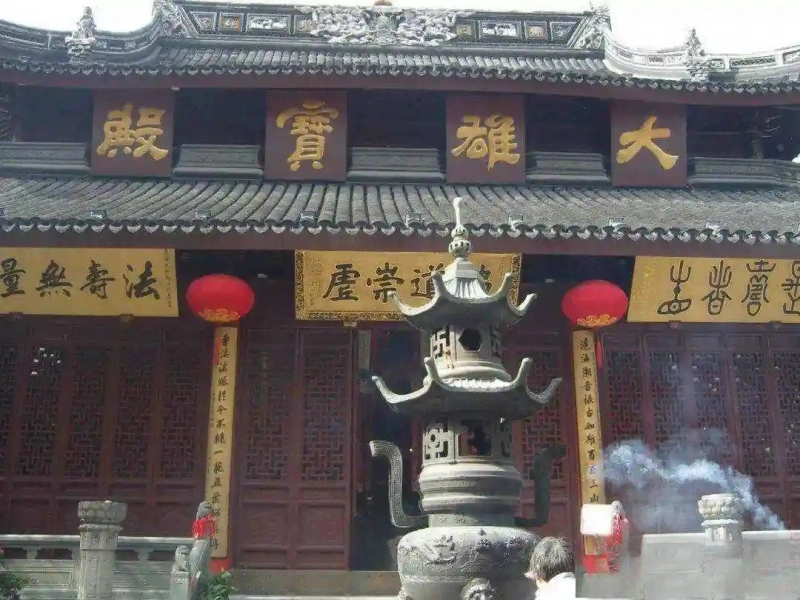
เจดีย์จิ้งอัน (Jìng’ān Bǎotǎ)
เจดีย์จิ้งอันเป็นเจดีย์ทรงสี่เหลี่ยมเจ็ดชั้น กินพื้นที่ 85 ตารางเมตร พื้นที่ใช้สอยกว่า 952 ตารางเมตร ยอดเจดีย์ทำด้วยทองสัมฤทธิ์และปิดทองแบบ “บัลลังก์วัชระ” ด้านหลังพระอุโบสถใหญ่มีหอทองคำบนชั้นบนสุดของหอธรรม ภายในประดิษฐานพระพุทธรูปศากยมุนีทองคำหนัก 2 ตัน ออกแบบเลียนแบบสถาปัตยกรรมสมัยซ่ง ใช้ไม้สักและหลังคาทองสัมฤทธิ์เป็นหลัก ที่มุมตะวันออกและตะวันตกของหอธรรมยังมีหอ “จื้อเอิน” และ “เป่าเอิน” สูง 20 เมตร ตั้งคู่กับหอระฆังและหอกลอง ช่วยเสริมความสมมาตรและงดงามให้กับสถาปัตยกรรมของวัด
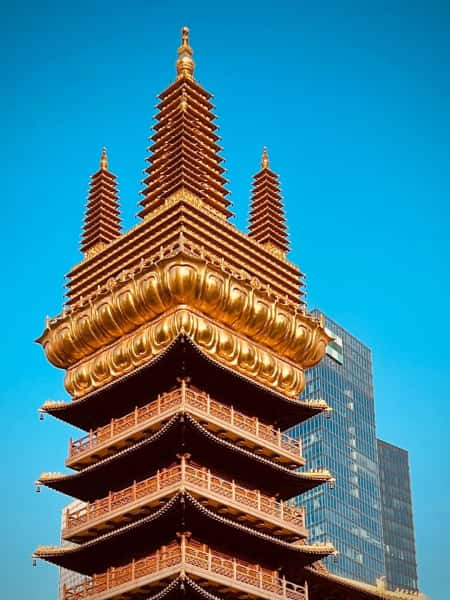
คู่มือบัตรเข้าชมวัดจิ้งอัน
ราคาบัตรเข้าชม
- ราคา: 50 หยวน / คน
- ฟรี: เด็กที่มีส่วนสูงไม่เกิน 120 ซม.
- วันสำคัญทางพุทธศาสนา (วันถือศีลใหญ่):
- บัตรเข้าชม: ฟรี
- วันเวลา: ทุกวันขึ้น 1 ค่ำ และ 15 ค่ำ ตามปฏิทินจันทรคติ
วิธีซื้อตั๋ว
- ออนไลน์: สามารถจองผ่านมินิโปรแกรม WeChat ของวัดจิ้งอัน
- ออฟไลน์ (แนะนำ): ซื้อที่หน้าประตูวัดโดยการสแกน QR code ราคาจะเท่ากับการซื้อตั๋วออนไลน์
บริการไกด์นำเที่ยววัดจิ้งอัน
วัดจิ้งอันไม่มีบริการไกด์อย่างเป็นทางการ เนื่องจากพื้นที่วัดไม่ใหญ่มาก เหมาะแก่การเดินชมเอง หากคุณต้องการเข้าใจประวัติศาสตร์และวัฒนธรรมของวัดรวมถึงสถานที่ใกล้เคียงมากขึ้น แนะนำให้จองทัวร์วันเดียวผ่านแพลตฟอร์มท่องเที่ยวออนไลน์ ซึ่งทัวร์เหล่านี้มักรวมถึงวัดจิ้งอันและแลนด์มาร์กสำคัญของเซี่ยงไฮ้ เช่น Yu Garden ถนนหนานจิง และ The Bund เพื่อให้คุณได้สัมผัสประสบการณ์วัฒนธรรมอย่างรอบด้าน
คู่มือการขอพรที่วัดจิ้งอัน
ที่วัดจิ้งอัน คุณสามารถสัมผัสประเพณีการขอพรแบบดั้งเดิมของชาวจีน วัดแห่งนี้เป็นสถานที่ศักดิ์สิทธิ์ที่ชาวเมืองนิยมมาสักการะและฝากความปรารถนาเอาไว้
- การจุดธูป: มีจุดบริการสำหรับจุดธูป ธูปหนึ่งชุดราคา 10 หยวน ตามธรรมเนียมต้องใช้มือซ้ายในการจุด เพื่อแสดงความเคารพต่อสิ่งศักดิ์สิทธิ์
- การอธิษฐาน: ยืนหน้าพระอุโบสถ หลับตาและตั้งจิตอธิษฐาน พร้อมกล่าวชื่อ วันเดือนปีเกิด ที่อยู่ และความปรารถนาของตน จากนั้นทำความเคารพ 3 ครั้งต่อหน้าพระอุโบสถ และไหว้ตามเข็มนาฬิกาอีก 3 ครั้งในแต่ละทิศทั้งสามด้าน เพื่อความสมบูรณ์
- การขอพร: ลานกลางมี “ถังธูปมหาสุขและปัญญา” นักท่องเที่ยวสามารถนำเหรียญมาโยนลงไปในถัง พร้อมตั้งจิตอธิษฐาน เพื่อความสมหวัง นอกจากนี้ยังมีบริการสแกน QR code เพื่อแลกเหรียญที่หน้างาน เพิ่มความสะดวกสบาย
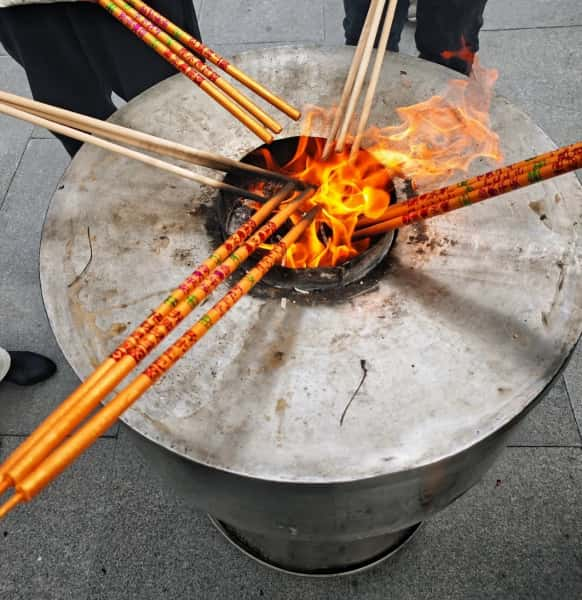
วิธีเดินทางจากใจกลางเมืองเซี่ยงไฮ้มายังวัดจิ้งอัน
รถไฟฟ้าใต้ดิน
นั่งรถไฟฟ้าใต้ดินสาย 2 หรือสาย 7 ลงที่สถานี Jing’an Temple ออกทางออก 1 หรือ 5 ก็จะถึงวัดทันที สะดวกและรวดเร็วมาก
รถบัส
- ป้าย Jiaozhou Road: สาย 21, 825
- ป้าย Meiliyuen: สาย 37, 62, 562, 838
- ป้าย Anyi Road: สาย 57
ทุกป้ายรถบัสนี้อยู่รอบๆ วัด เดินเพียงไม่กี่นาทีก็ถึง
แท็กซี่ / บริการเรียกรถ
หากเลือกนั่งแท็กซี่หรือใช้บริการเรียกรถ เพียงใส่จุดหมายว่า “Jing’an Temple” ก็สามารถเดินทางได้สะดวก จากใจกลางเมืองเซี่ยงไฮ้ใช้เวลาไม่นาน เหมาะสำหรับผู้ที่ไม่คุ้นเคยเส้นทางรถไฟฟ้า
แนะนำร้านอาหารใกล้วัดจิ้งอัน
- FINE FAN zakka&canteen (Shanghai X88 Branch)
- ที่อยู่: 58 ถนนถงเหริน เขตจิ้งอัน (ออกจากสถานี Jing’an Temple ทางออก 8 เดินประมาณ 260 ม.)
- เหตุผลที่แนะนำ: บรรยากาศอบอุ่น เหมาะสำหรับการพักผ่อนพร้อมอาหารอร่อย
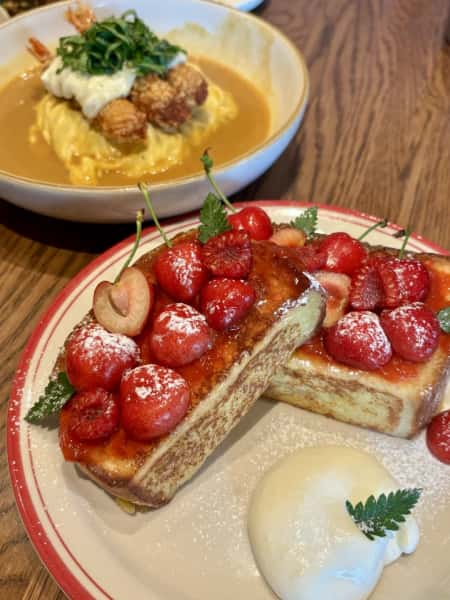
- Renheguan (สาขา Jing’an Temple)
- ที่อยู่: 142 ถนนหยู่หยวน เขตจิ้งอัน (ออกจากสถานี Jing’an Temple ทางออก 2 เดินประมาณ 190 ม.)
- เหตุผลที่แนะนำ: ต้องลองบะหมี่ปลาเหลืองกับปู ไข่แดงเข้มข้น รสชาติกลมกล่อม
- KLAY Modern Indian Restaurant
- ที่อยู่: บริเวณใกล้เขตจิ้งอัน
- เหตุผลที่แนะนำ: อาหารอินเดียบรรยากาศแปลกใหม่ เหมาะสำหรับผู้ที่ชอบลิ้มลองรสชาติแบบนานาชาติ
- Hu Xi Lao Nongtang Noodle Shop (สาขา Jing’an Temple)
- ที่อยู่: 1738 ถนนปักกิ่งตะวันตก เขตจิ้งอัน (ออกจากสถานี Jing’an Temple ทางออก 1 เดินประมาณ 360 ม.)
- เหตุผลที่แนะนำ: เส้นบะหมี่เหนียวนุ่มอร่อยมาก แต่ถ้ามาช่วงคนเยอะอาจต้องรอสักหน่อย
คำถามที่พบบ่อย
พื้นที่หลักของวัดเป็นทางเดินหินและบันได ทำให้การเข็นรถเด็กอาจไม่สะดวกนัก แนะนำให้ครอบครัวที่มีเด็กเล็กใช้เป้อุ้มเด็กแบบสะพาย จะง่ายต่อการชมสถานที่ หากจำเป็นต้องใช้รถเข็น ควรเลือกแบบพับเก็บได้หรือแบบน้ำหนักเบา เพื่อสะดวกในการใช้งานเมื่อเจอทางแคบหรือพื้นที่ที่มีผู้คนหนาแน่น
รวมลิงก์แนะนำเที่ยวเซี่ยงไฮ้ที่จำเป็น
- คู่มือเที่ยวเซี่ยงไฮ้ฉบับสมบูรณ์ 📖
- แนะนำสถานที่ท่องเที่ยวและแผนเที่ยวเซี่ยงไฮ้ 🏙️
- แนะนำที่พัก 🏨
- คู่มือการเดินทาง ✈️ 🚇 🚄 🚆
- เคล็ดลับและข้อมูลจำเป็นในการเที่ยวเซี่ยงไฮ้ 🗺️ 🍜 📱 💸 🌤️ 💊🛍️🔌📶🧳
- 🗺️ แผนที่เซี่ยงไฮ้
- 🍜 แนะนำอาหารอร่อยในเซี่ยงไฮ้
- 🎁 แนะนำของฝากจากเซี่ยงไฮ้
- 📱 แอปพลิเคชันจำเป็นสำหรับการท่องเที่ยว
- 💸 คู่มือขอคืนภาษี (Tax Refund) ในจีน
- 🌤️ ข้อมูลสภาพอากาศเซี่ยงไฮ้
- 💊 รายการยาจำเป็นที่ควรนำไปเที่ยวจีน
- 🛍️ ดีลท่องเที่ยวในประเทศจีน
- 🔌 ปลั๊กจีน แรงดันไฟฟ้า และคู่มือปลั๊กไฟจีน
- 📶 วิธีการใช้ eSIM ในประเทศจีน
- 🧳 รายการบรรจุภัณฑ์และเช็คลิสต์การเดินทาง

 English (US)
English (US)  繁體中文
繁體中文 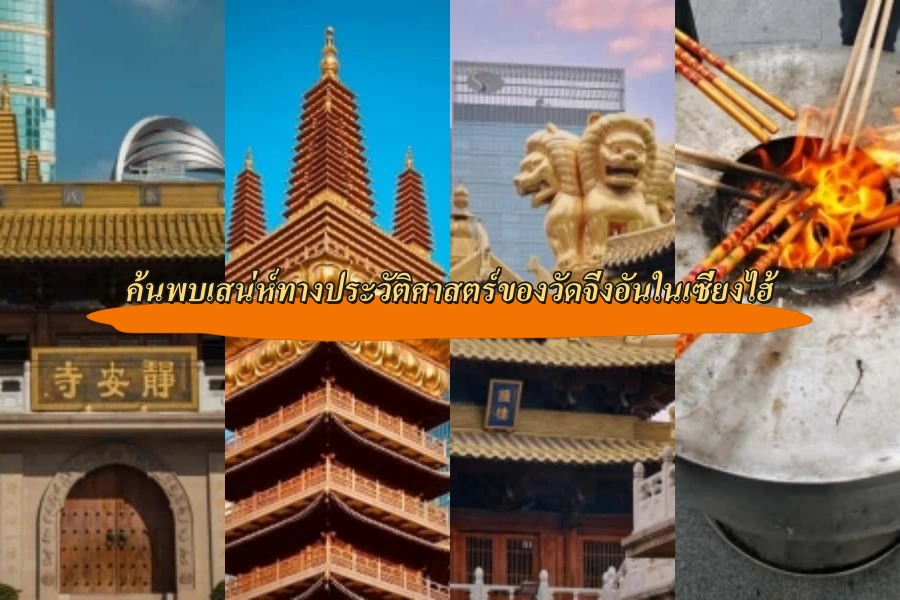
Comment (0)